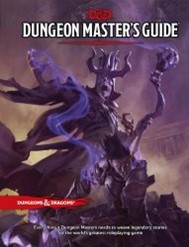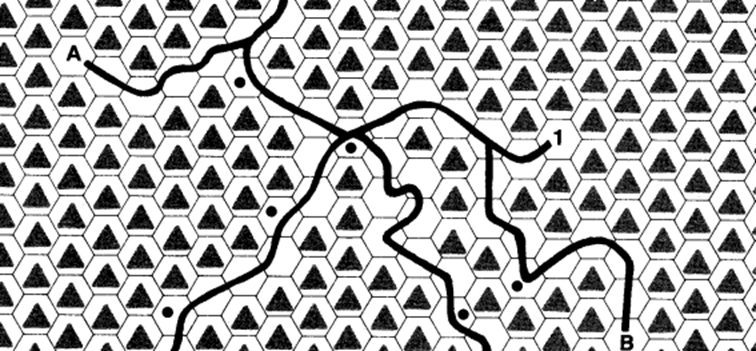 Although hex-based exploration was the dominant form of wilderness exploration in the early days of Dungeons & Dragons, a few adventures used a hybrid approach that drew on dungeon design. That is, they limited the ways that players could move between encounters. Occasionally they would be hard limits – the depiction of the Underdark in Descent into the Depths of the Earth was that way – but more often they would give easy paths between encounters while players could still take harder routes through untracked wilderness. The adventure Lost Caverns of Tsojcanth was that way. Players would typically travel along the valleys/mountain paths between encounters, but they could go across the mountains if they wished.
Although hex-based exploration was the dominant form of wilderness exploration in the early days of Dungeons & Dragons, a few adventures used a hybrid approach that drew on dungeon design. That is, they limited the ways that players could move between encounters. Occasionally they would be hard limits – the depiction of the Underdark in Descent into the Depths of the Earth was that way – but more often they would give easy paths between encounters while players could still take harder routes through untracked wilderness. The adventure Lost Caverns of Tsojcanth was that way. Players would typically travel along the valleys/mountain paths between encounters, but they could go across the mountains if they wished.
Mountains are a pretty good way of channelling players, because it’s very hard to just cross a mountain. Tracks and paths through forests also provide a way of presenting options for movement that aren’t hard limits but still help focus the choices of the players. Once you get to fields and plains, then the obstacles for moving off the paths are much less, but roads and trails still give the players guidance on which way to go.
Offering guidance to players is tremendously useful. Although most players don’t like having their decisions being made for them, I’ve seen many confused faces when I give players a blank map and ask them where they want to go. So, giving them a set of limited options (while still allowing player choice) and also offering them the greater potential of having an encounter at the end of the journey is a useful technique to employ.
In this style of wilderness exploration, the players are still exploring the wilderness and they don’t know how it is all laid out. For obvious reasons, you should put most of the set encounters along the pathways or at their destinations (mountain valleys, forest glades and the like). Having set encounters off the paths works best if they’re linked to a pathway encounter. So, the bandits could ambush the players on the road, but clever players could track them to their lair, deep in the untracked forest. There you can place treasure, more monsters, and perhaps a trick or two.
Off-the-track encounters could also be indicated by visual signs: a pillar of smoke or circling birds, for instance. Things that give players a reason to leave the path.
When designing this type of wilderness, you still need to draw a map of the area, and key encounters to hexes on the map. A random table of encounters allows you to provide uncertainty, as well as giving you more options if the players go off-track.
The odd off-track encounter that doesn’t have clues to its existence is fine, but you do have a perennial problem with D&D adventure design: Designing encounters that no-one actually sees. With a published adventure, even the more obscure encounters are likely to be discovered by a group of players. When you design only for your own group, you can waste a lot of time designing encounters that they never get to! Which is why guiding the characters down paths can be so effective.
The next article in this series will look at wilderness travel when they players know where they’re going – and when you can abandon the hex grid!

A section of the wilderness map from the Lost Caverns of Tsojcanth.

Although most players don’t like having their decisions being made for them, I’ve seen many confused faces when I give players a blank map and ask them where they want to go.
Players should think of their characters motivation at that point. And if they just made up a character motivation to appease the GM who asked for it but the player doesn’t really care about playing it out, they are pretty much doomed (in the riddle of steel RPG that’d mean you’d miss out on the bonus dice that make the difference between surviving a fight and getting your head cut off!)!
On unseen encounters, I think a method is to have the same encounter at the end of two paths, but modified by the path. Say one path leads to the top of a volcano and the other to the bottom of an icy chasm – the same encounter could be used either way, but some of the encounter monsters replaced with fire monster for the volcano and some replaced with ice monsters if they go to the icy chasm. Thus the players choices have modified what they run into, to some degree. And of course broader changes than just a monster switch could be applied as well, to increase the amount of modification.
Another method is to have a series of encounters that could be dropped anywhere the players go and simply grenade them in at various times when the pace is due to be upped. These encounters aren’t used in a sequence – just the ones that seem to best suit the current location of the players. Any unused encounters can be tweaked a bit and be ready for potential use next time, should they seem the right fit.
Gah, my post got long – I thought I was going to write a short one! 🙂